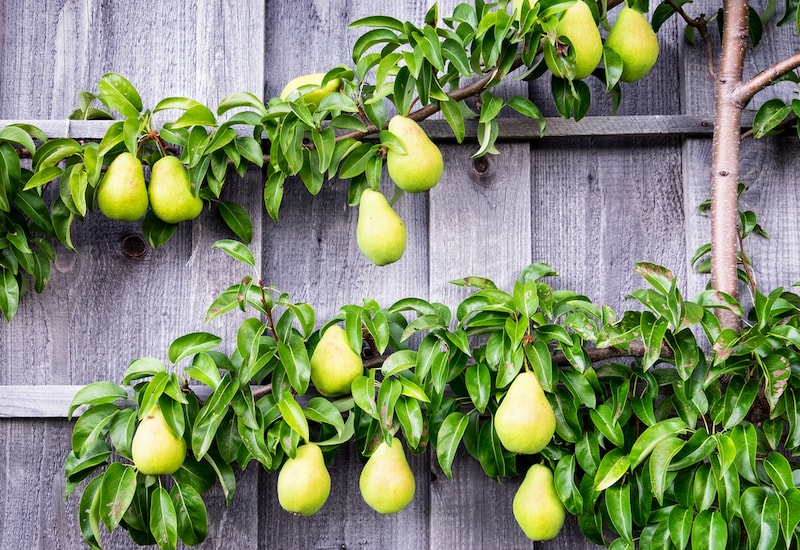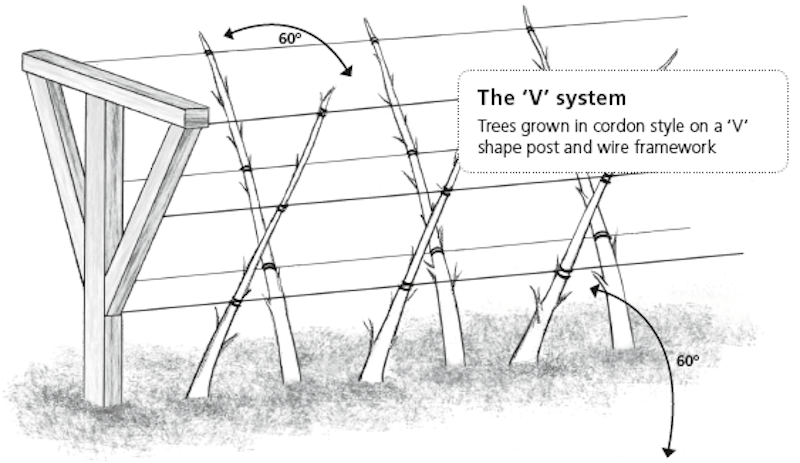Pears are a very rewarding crop as they’re easy to grow, suffer from few pests and diseases and, if properly ripened, are among the most delicious of all tree fruits. Unlike some, pear trees seem to improve with age and even very old specimens can be highly productive. Here’s everything you need to know about planting, growing, pruning and harvesting pears.
Where to grow pears
Pears thrive in a sunny, sheltered spot in fertile, well-drained soil. Avoid planting your pears in frost pockets because they blossom early and cold weather can reduce cropping significantly. A warm position against a south-facing wall or fence is ideal. A slightly acidic soil with a pH of between 6.0 and 6.5 is ideal for growing pears, but they’ll tolerate neutral soils without much problem. If possible, grow more than one pear tree because, like apples, lots of varieties require a partner tree in order to pollinate properly.
How to plant a pear tree

Image: Pear Tree ‘Buerre Hardy’ from Suttons
Pears are grafted to standardised quince rootstocks, allowing you to choose the type of tree best suited to your preferred growing technique. For espalier or bush trees, choose ‘Quince A’ root stocks – these are the most vigorous; for cordon grown pears and for container growing, choose ‘Quince C’. You should plant bare root pear trees during their dormant phase from October through to the following March – once spring has sprung, it’s too late. Container-grown trees can be planted all year round.
To plant a pear in a container, make sure you choose a variety cultivated for that purpose. Choose a suitable sized pot and, placing some broken concrete or polystyrene in the base to aid with drainage, top up with a loam-based compost like John Innes No.3.
When planting pears into the ground, dig a hole as deep as the roots but three times their circumference. Make sure you spread the roots out in the hole and carefully back fill it, packing the soil between the roots to expel all the air. Tamp down firmly and apply a mulch of well-rotted compost or manure.
Growing styles for pears

Image: FooTToo/Shutterstock
Most of the growing styles, spacings, and pruning methods used for apples can be applied to pear trees. As they naturally produce good quantities of fruiting spurs, cordon growing is a good choice. Simply plant your trees 2.5 to 3’ apart, either against a wall or in open ground, staking each tree individually.
Grow bush pear trees 3–3.5m (10–12′) apart. Once planted, the central leader (main stem) should be cut back to the highest side branch or feather. This encourages feathers to develop and these should be limited to eight good branches in a tight ‘wine glass’ shape. At the end of the first growing year these branches should be cut back by half. This promotes the development of fruiting spurs which are then pruned back in turn to three buds.
The modern ‘V’ System can be seen on some of the best commercial fruit farms and is an adaptation of the cordon method. Pear trees are planted alternately along a row at an angle of 60 degrees to the ground, forming a V along the row plant 45cm (18″) apart. Trees are supported by a framework of posts and wires. The general culture and pruning is as for the cordon. These trees intercept a very high proportion of the available sunlight and the quality of fruit produced is very high. After five years, yields of 4.5kg (10lb) per tree can be expected.

How to care for pear trees
Pears need remarkably little maintenance. Simply apply a good mulch once each year during the autumn and prune twice a year, once during the depths of winter to remove dead, damaged, or diseased wood and once during the summer to improve the shape and open up the crown to more light and air circulation.
Pears require plenty of water and should never be subjected to drought conditions. In particular, regular watering in the month following flowering will bring great dividends in terms of fruit quality. An application of a good slow-release nitrogenous fertiliser at around the third week in August will greatly improve the following year’s fruit buds.
When to harvest pears

Image: Floramedia
Pears are ready for picking from late August when they’re mature but not yet fully ripe. They should come off the branch with a lift and gentle twist. If they resist, leave them for a little longer. Store your pears as you would apples – without the skins touching, in a cool dark place. When you want to bring your pears to ripeness, bring them inside for a few days. Pears ripen from the inside out; to tell if a pear is ready, press your thumb to the neck and give it a squeeze – if it gives, it’s ripe.
Pears are one of the juiciest, most delicious fruits and they grow so well here in the UK that it would be a shame to miss out. Fancy a small orchard? See our full range of fruit trees and start planning all the different ways to enjoy your homegrown harvests. No room for more trees? Soft fruit is another good option.
Lead image: Pear Tree – Conference from Suttons
Last Updated on November 8, 2024 by Suttons Horticultural Team





